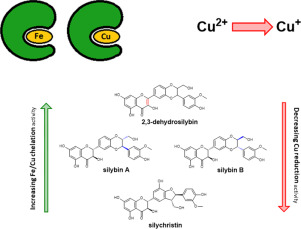Journal of Inorganic Biochemistry ( IF 3.8 ) Pub Date : 2018-09-13 , DOI: 10.1016/j.jinorgbio.2018.09.006 Václav Tvrdý , Maria Carmen Catapano , Tomasz Rawlik , Jana Karlíčková , David Biedermann , Vladimír Křen , Přemysl Mladěnka , Kateřina Valentová

|
Silymarin, the standardized extract from the milk thistle (Silybum marianum), is composed mostly of flavonolignans and is approved in the EU for the adjuvant therapy of alcoholic liver disease. It is also used for other purported effects in miscellaneous nutraceuticals. Due to polyhydroxylated structures and low systemic bioavailability, these flavonolignans are likely to interact with transition metals in the gastrointestinal tract. The aim of this study was to analyze the interactions of pure silymarin flavonolignans with copper and iron. Both competitive and non-competitive methods at various physiologically relevant pH levels ranging from 4.5 to 7.5 were tested. Only 2,3‑dehydrosilybin was found to be a potent or moderately active iron and copper chelator. Silybin A, silybin B and silychristin A were less potent or inactive chelators. Both 2,3‑dehydrosilybin enantiomers (A and B) were equally active iron and copper chelators, and the preferred stoichiometries were mainly 2:1 and 3:1 (2,3‑dehydrosilybin:metal). Additional experiments showed that silychristin was the most potent iron and copper reductant. Comparison with their structural precursors taxifolin and quercetin is included as well. Based on these results, silymarin administration most probably affects the kinetics of copper and iron in the gastrointestinal tract, however, due to the different interactions of individual components of silymarin with these transition metals, the biological effects need to be evaluated in the future in a much more complex study.
中文翻译:

分离的水飞蓟素黄酮木聚糖与铁和铜的相互作用
水飞蓟素,水飞蓟(水飞蓟)的标准化提取物),主要由黄酮木聚糖组成,并已在欧盟批准用于酒精性肝病的辅助治疗。它也可用于其他保健食品中的其他据称功效。由于多羟基化的结构和较低的全身生物利用度,这些黄酮木聚糖很可能与胃肠道中的过渡金属相互作用。这项研究的目的是分析纯水飞蓟素黄酮木聚糖与铜和铁的相互作用。在4.5至7.5的各种生理相关pH值水平下,均测试了竞争性和非竞争性方法。仅发现2,3-去氢水飞蓟宾为有效或中等活性的铁和铜螯合剂。水飞蓟宾A,水飞蓟宾B和水飞蓟素A的效价或活性较低。两者2 3-去氢水飞蓟宾对映异构体(A和B)是同等活性的铁和铜螯合剂,优选的化学计量比主要为2:1和3:1(2,3-去氢水飞蓟宾:金属)。其他实验表明,水飞蓟素是最有效的铁和铜还原剂。还包括与它们的结构前体滑石粉和槲皮素的比较。根据这些结果,水飞蓟素的给药很可能会影响胃肠道中铜和铁的动力学,但是,由于水飞蓟素的各个成分与这些过渡金属之间的相互作用不同,因此有必要在未来评估其生物学效应。更复杂的研究。其他实验表明,水飞蓟素是最有效的铁和铜还原剂。还包括与它们的结构前体滑石粉和槲皮素的比较。根据这些结果,水飞蓟素的给药很可能会影响胃肠道中铜和铁的动力学,但是,由于水飞蓟素的各个成分与这些过渡金属之间的相互作用不同,因此有必要在未来评估其生物学效应。更复杂的研究。其他实验表明,水飞蓟素是最有效的铁和铜还原剂。还包括与它们的结构前体滑石粉和槲皮素的比较。根据这些结果,水飞蓟素的给药很可能会影响胃肠道中铜和铁的动力学,但是,由于水飞蓟素的各个成分与这些过渡金属之间的相互作用不同,因此有必要在未来评估其生物学效应。更复杂的研究。











































 京公网安备 11010802027423号
京公网安备 11010802027423号